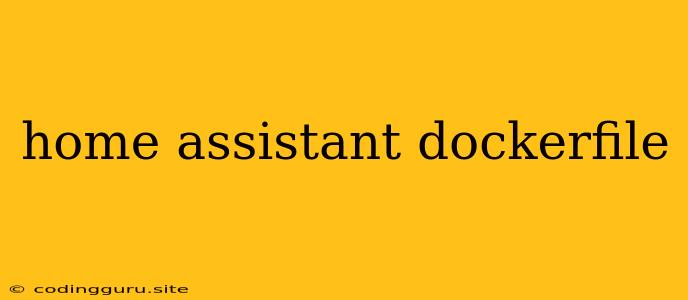Home Assistant in a Docker Container: A Comprehensive Guide
Running Home Assistant within a Docker container offers numerous benefits, such as easy installation, updates, and portability. This guide will walk you through the essential steps to set up Home Assistant with Docker, addressing common questions and providing solutions to potential hurdles.
Why Choose Docker for Home Assistant?
Docker allows you to encapsulate Home Assistant and its dependencies within a self-contained environment. This provides the following advantages:
- Simplified Installation: Docker eliminates the need for manual installation and configuration of Home Assistant and its required software.
- Version Control: You can easily switch between different versions of Home Assistant by pulling different Docker images.
- Isolated Environment: Docker isolates Home Assistant from your host system, preventing conflicts and potential issues.
- Portability: You can move your Home Assistant Docker container between different systems without significant effort.
Creating Your Dockerfile: Building the Foundation
The foundation of your Home Assistant Docker setup is the Dockerfile. Here's a sample Dockerfile that can be used as a starting point:
FROM homeassistant/home-assistant:latest
# Set the timezone
ENV TZ=America/Los_Angeles
# Copy your configuration files
COPY configuration.yaml /config
# Expose the Home Assistant web interface
EXPOSE 8123
# Define the entry point for the container
ENTRYPOINT ["/usr/local/bin/hass"]
Explanation:
FROM homeassistant/home-assistant:latest: This line specifies the base image for your Docker container. In this case, we are using the official Home Assistant Docker image, pulling the latest version.ENV TZ=America/Los_Angeles: Sets the timezone for your container. ReplaceAmerica/Los_Angeleswith your desired timezone.COPY configuration.yaml /config: This line copies your Home Assistant configuration file (configuration.yaml) from your host system into the container.EXPOSE 8123: Exposes port 8123 within the container, allowing access to the Home Assistant web interface from your host machine.ENTRYPOINT ["/usr/local/bin/hass"]: Defines the command that will be executed when the container starts, in this case, the Home Assistant executable.
Essential Configuration: Tailoring Your Setup
Within your configuration.yaml, you'll need to configure various aspects of Home Assistant, including network settings, integrations, and add-ons.
Network Configuration:
http:: Configure the IP address and port for your Home Assistant instance. If you plan to access Home Assistant from external networks, ensure your router is properly configured to forward traffic to the port exposed by your container.external_url:: Define the URL used to access Home Assistant from external networks.
Integrations:
- Define the integrations you want to use, such as your smart home devices, weather services, and other services. You'll need to configure the specific settings for each integration within your
configuration.yaml.
Add-ons:
- Home Assistant's add-ons extend its functionality. Install and configure add-ons such as Mosquitto (for MQTT) or Samba (for file sharing) within the container.
Building and Running Your Docker Image
After creating your Dockerfile, you can build your Docker image using the following command:
docker build -t home-assistant .
Replace home-assistant with the desired name for your image.
Once the image is built, you can start a container using the following command:
docker run -d -p 8123:8123 --name home-assistant home-assistant
This command will:
-d: Run the container in detached mode (in the background).-p 8123:8123: Map port 8123 on your host system to port 8123 within the container.--name home-assistant: Assign the namehome-assistantto your container.home-assistant: Use the previously built Docker image namedhome-assistant.
Troubleshooting Common Issues
Here are some common issues you may encounter when setting up Home Assistant with Docker and their potential solutions:
- Error: "Cannot connect to the Docker daemon": Ensure Docker is properly installed and running on your system.
- Error: "Error: Cannot find the specified image": Verify that you built the Docker image correctly and that the name you are using in the
docker runcommand matches the name of the image. - Error: "Failed to connect to the Home Assistant instance": Ensure your network configuration is correct and that the port mapping in the
docker runcommand is accurate. - Error: "Integration fails to load": Check your
configuration.yamlfile for any syntax errors or incorrect settings for the integration.
Advanced Techniques: Optimizing Your Setup
Persistent Storage:
Use Docker volumes to store your Home Assistant configuration and data persistently. This ensures your data survives container restarts.
Automated Updates:
Configure Docker to automatically pull updates for your Home Assistant image. This ensures your Home Assistant installation is always up-to-date.
Network Bridging:
Use Docker networking features to create a dedicated network for your Home Assistant container, allowing smooth communication with your smart home devices.
Container Monitoring:
Use Docker monitoring tools to track container resource usage, performance, and potential errors.
Conclusion
Running Home Assistant in a Docker container offers a streamlined and efficient approach to managing your smart home hub. This guide provided a step-by-step approach to creating, configuring, and running Home Assistant within a Docker environment, covering essential configuration and troubleshooting tips. By leveraging the power of Docker, you can simplify your Home Assistant setup and enjoy the benefits of a robust, scalable, and easily manageable system.
